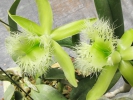|
|
|
|
|
| |
Established Seedlings of
Rhyncholaelia digbyana 'Queen of the Catts' × self |
|
| |
|
|
| |
| Number: |
TN7926 |
| Name: |
Rhyncholaelia digbyana 'Queen of the Catts' × self
|
| Type: |
self (What's that?) |
|
Seed Donor: |
Mr Gareth Wills
|
|
Click to Enlarge

Pod Parent Flowers |
Click to Enlarge

Pod Parent Blooming Plant |
|
|
|
| |
Comments: Parent plant: Plant is the offspring of 'Laura' × 'Mrs. Chase'.
For additional origin/habitat information supplied courtesy of
Charles and Margaret Baker, see further below, near the bottom of this page.
|
Temperatures we attempt to use in the lab & greenhouse:
| For Species: |
|
Spring, Summer, Autumn: days average 88°F, nights 75°F; best fit is Warm 90-70°F
(Source:
Baker's Web OSC) |
| For Species: |
|
Winter: days average 82°F, nights 68°F; best fit is Warm-Intermediate 87-64°F
(Source:
Baker's Web OSC) |
|
About the name...
| Etymology of |
digbyana |
|
Named for St. Vincent Digby, English orchid enthusiast of the 19th century.
(Source:
Mayr & Schmucker 1998) |
| Etymology of |
Rhyncholaelia |
|
From latinized Greek "rhynchos" beak. From the elongated fruit and some similarities to the genus Laelia.
(Source:
Mayr & Schmucker 1998) |
| Pronunciation of |
digbyana |
|
dig-bee-AH-na
(Source:
Hawkes 1978) |
| Pronunciation of |
Rhyncholaelia |
|
rink-oh-LYE-lee-ah
(Source:
Hawkes 1978) |
|
If you would like to direct someone to this web page, please copy and paste this URL into your email:
http://troymeyers.com/d?127926
|
ESTABLISHED SEEDLINGS
of these are not currently available, but we have some maturing in the greenhouse and expect to offer them in the future.
There are 6 items with
1 plant per
item that will be considered for sale later.
Click here to see if we have flasks available.
|
|
|
| |
The origin/habitat information below is supplied courtesy of Charles and Margaret Baker
The following information is based on the name of the plant provided by the donor, and assumes that the name is correct. If the plant has been misidentified, then the following information may not be correct.
This text is copyrighted by the Bakers and may not be reproduced without permission.
ORIGIN/HABITAT: Plants are found in the southeastern Mexican states of
Yucatan and Quintana Roo with distribution extending through the
Caribbean-facing lowlands of Belize into Honduras. They grow on stunted
trees in hot, humid lowlands near sea level. There have been some reports
of occurrences in Nicaragua and Guatemala, but we have been unable to
locate any details relating to collections or habitat location in these
areas.
More about this information and the Bakers...
|
|
|
| |
|
|
|